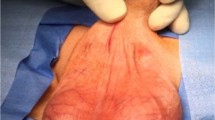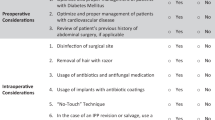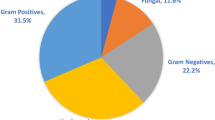Abstract
Purpose
The aim of this study was to identify the factors associated with infection in patients who undergo penile prosthesis implantation.
Methods
We performed a systematic review/meta-analysis, including clinical trials, quasi-experiments, retrospective and prospective cohort studies, and case-control studies. Searching was done in CENTRAL, MEDLINE, and EMBASE databases. Participants were patients who had erectile dysfunction, regardless of the etiology, and underwent penile prosthesis implantation. Two researchers reviewed each reference by title and abstract. The statistical analysis was performed using Review Manager 5.3 (RevMan® 5.3).
Results
A total of 513 studies were found with the search strategies. After excluding duplicates, 40 studies with a total of 175,592 patients were included in the qualitative and quantitative analysis. Among patient characteristics, we found that diabetes mellitus and immunosuppression appear to have increase odds of infection. Related to the procedure, infection-retardant-coated penile prosthesis and primary (first) surgery appear to lower odds of infection.
Conclusions
Diabetes mellitus and immunosuppression were associated with increased infection rates; infection-retardant coating of the prosthesis and primary surgery were associated with reduced infection rates.
This is a preview of subscription content, access via your institution
Access options
Subscribe to this journal
Receive 8 print issues and online access
$259.00 per year
only $32.38 per issue
Buy this article
- Purchase on Springer Link
- Instant access to full article PDF
Prices may be subject to local taxes which are calculated during checkout



Similar content being viewed by others
References
NIH Consensus Conference. Impotence. NIH consensus development panel on impotence. JAMA. 1993;270:83–90.
Rew KT, Heidelbaugh JJ. Erectile dysfunction. Am Fam Phys. 2016;94:820–7.
Billups KL, Bank AJ, Padma-Nathan H, Katz S, Williams R. Erectile dysfunction is a marker for cardiovascular disease: results of the minority health institute expert advisory panel. J Sex Med. 2005;2:50–2.40–50.
Eardley I. The incidence, prevalence, and natural history of erectile dysfunction. Sex Med Rev. 2013;1:3–16.
Johannes CB, Araujo AB, Feldman HA, Derby CA, Kleinman KP, McKinlay JB. Incidence of erectile dysfunction in men 40 to 69 years old: longitudinal results from the Massachusetts male aging study. J Urol. 2000;163:460–3.
Hatzimouratidis K, Amar E, Eardley I, Giuliano F, Hatzichristou D, Montorsi F, et al. Guidelines on male sexual dysfunction: erectile dysfunction and premature ejaculation. Eur Urol. 2010;57:804–14.
Darouiche RO. Treatment of infections associated with surgical implants. N Engl J Med. 2004;350:1422–9.
Hofer MD, Gonzalez CM. Current concepts in infections associated with penile prostheses and artificial sphincters. Urol Clin N Am. 2015;42:485–92.
Muench PJ. Infections versus penile implants: the war on bugs. J Urol. 2013;189:1631–7.
Mirheydar H, Zhou T, Chang DC, Hsieh T-C. Reoperation rates for penile prosthetic surgery. J Sex Med. 2016;13:129–33.
Carson CC. Infections in genitourinary prostheses. Urol Clin N Am. 1989;16:139–47.
Darouiche RO, Bella AJ, Boone TB, Brock G, Broderick GA, Burnett AL, et al. North American consensus document on infection of penile prostheses. Urology. 2013;82:937–42.
Dawn LE, Henry GD, Tan GK, Wilson SK. Biofilm and infectious agents present at the time of penile prosthesis revision surgery: times are a changing. Sex Med Rev. 2017;5:236–43.
Wilson SK, Costerton JW. Biofilm and penile prosthesis infections in the era of coated implants: a review. J Sex Med. 2012;9:44–53.
Henry GD, Wilson SK, Delk JR, Carson CC, Silverstein A, Cleves MA, et al. Penile prosthesis cultures during revision surgery: a multicenter study. J Urol. 2004;172:153–6.
Mulcahy JJ, Kramer A, Brant WO, Parker JL, Perito PE, Myers JB, et al. Current management of penile implant infections, device reliability, and optimizing cosmetic outcome. Curr Urol Rep. 2014;15:413.
Gross MS, Phillips EA, Carrasquillo RJ, Thornton A, Greenfield JM, Levine LA, et al. Multicenter investigation of the microorganisms involved in penile prosthesis infection: an analysis of the efficacy of the AUA and EAU guidelines for penile prosthesis prophylaxis. J Sex Med. 2017;14:455–63.
Pineda M, Burnett AL. Penile prosthesis infections—a review of risk factors, prevention, and treatment. Sex Med Rev. 2016;4:389–98.
Higgins J, Green S, Editors. Cochrane handbook for systematic reviews of interventions. http://handbook-5-1.cochrane.org/. Accessed 9 Jan 2018.
Liberati A, Altman DG, Tetzlaff J, Mulrow C, Gøtzsche PC, Ioannidis JPA, et al. The PRISMA statement for reporting systematic reviews and meta-analyses of studies that evaluate healthcare interventions: explanation and elaboration. BMJ. 2009;339:b2700.
Grewal S, Vetter J, Brandes SB, Strope SA. A population-based analysis of contemporary rates of reoperation for penile prosthesis procedures. Urology. 2014;84:112–6.
Wilson SK, Zumbe J, Henry GD, Salem EA, Delk JR, Cleves MA. Infection reduction using antibiotic-coated inflatable penile prosthesis. Urology. 2007;70:337–40.
Madbouly K, AlHajeri D, Habous M, Binsaleh S. Association of the modified frailty index with adverse outcomes after penile prosthesis implantation. Aging Male. 2017;20:119–24.
Xie D, Gheiler V, Lopez I, Nehrenz GM, Klopukh B, Bianco F, et al. Experience with prophylactic gentamicin during penile prosthesis surgery: a retrospective comparison of two different doses. J Sex Med. 2017;14:1160–4.
Sundaram V, Cordon BH, Hofer MD, Morey AF. Is risk of artificial urethral sphincter cuff erosion higher in patients with penile prosthesis? J Sex Med. 2016;13:1432–7.
Habous M, Farag M, Williamson B, Laban O, Mahmoud S, Abdelwahab O, et al. Conservative therapy is an effective option in patients with localized infection after penile implant surgery. J Sex Med. 2016;13:972–6.
Pineda M, Burnett AL. Distinguishing failure to cure from complication after penile prosthesis implantation. J Sex Med. 2017;14:731–7.
Balen A, Gross MS, Phillips EA, Henry GD, Munarriz R. Active polysubstance abuse concurrent with surgery as a possible newly identified infection risk factor in inflatable penile prosthesis placement based on a retrospective analysis of health and socioeconomic factors. J Sex Med. 2016;13:697–701.
Antonini G, Busetto GM, De Berardinis E, Giovannone R, Vicini P, Del Giudice F, et al. Minimally invasive infrapubic inflatable penile prosthesis implant for erectile dysfunction: evaluation of efficacy, satisfaction profile and complications. Int J Impot Res. 2016;28:4–8.
Garber BB, Bickell M. Subcutaneous placement of inflatable penile prosthesis reservoirs. Urology. 2016;88:93–6.
Segal RL, Cabrini MR, Harris ED, Mostwin JL, Bivalacqua TJ, Burnett AL. Combined inflatable penile prosthesis-artificial urinary sphincter implantation: no increased risk of adverse events compared to single or staged device implantation. J Urol. 2013;190:2183–8.
Chung E, Van CT, Wilson I, Cartmill RA. Penile prosthesis implantation for the treatment for male erectile dysfunction: clinical outcomes and lessons learnt after 955 procedures. World J Urol. 2013;31:591–5.
Nehra A, Carson CC, Chapin AK, Ginkel AM. Long-term infection outcomes of 3-piece antibiotic impregnated penile prostheses used in replacement implant surgery. J Urol. 2012;188:899–903.
Serefoglu EC, Mandava SH, Gokce A, Chouhan JD, Wilson SK, Hellstrom WJG. Long-term revision rate due to infection in hydrophilic-coated inflatable penile prostheses: 11-year follow-up. J Sex Med. 2012;9:2182–6.
Cuellar DC, Sklar GN. Penile prosthesis in the organ transplant recipient. Urology. 2001;57:138–41.
Garber BB, Marcus SM. Does surgical approach affect the incidence of inflatable penile prosthesis infection? Urology. 1998;52:291–3.
Govier FE, Gibbons RP, Correa RJ, Pritchett TR, Kramer-Levien D. Mechanical reliability, surgical complications, and patient and partner satisfaction of the modern three-piece inflatable penile prosthesis. Urology. 1998;52:282–6.
Wilson SK, Carson CC, Cleves MA, Delk JR. Quantifying risk of penile prosthesis infection with elevated glycosylated hemoglobin. J Urol. 1998;159:1537–9.
Jarow JP. Risk factors for penile prosthetic infection. J Urol. 1996;156:402–4.
Wilson SK, Delk JR. Inflatable penile implant infection: predisposing factors and treatment suggestions. J Urol. 1995;153:659–61.
Randrup ER. Clinical experience with 180 inflatable penile prostheses. South Med J. 1995;88:47–51.
Lynch MJ, Scott GM, Inglis JA, Pryor JP. Reducing the loss of implants following penile prosthetic surgery. Br J Urol. 1994;73:423–7.
Bishop JR, Moul JW, Sihelnik SA, Peppas DS, Gormley TS, McLeod DG. Use of glycosylated hemoglobin to identify diabetics at high risk for penile periprosthetic infections. J Urol. 1992;147:386–8.
Collins KP, Hackler RH. Complications of penile prostheses in the spinal cord injury population. J Urol. 1988;140:984–5.
Sun AY, Babbar P, Gill BC, Angermeier KW, Montague DK. Penile prosthesis in solid organ transplant recipients—a matched cohort study. Urology. 2018;117:86–8.
Loh-Doyle J, Patil MB, Sawkar H, Wayne K, Boyd SD. 3-piece inflatable penile prosthesis placement following radical cystoprostatectomy and urinary diversion: technique and outcomes. J Sex Med. 2018;15:907–13.
Canguven O, Talib R, El Ansari W, Khalafalla K, Al Ansari A. Is Hba1c level of diabetic patients associated with penile prosthesis implantation infections? Aging Male. 2018:1–6.
Habous M, Tal R, Tealab A, Soliman T, Nassar M, Mekawi Z, et al. Defining a glycated haemoglobin (HbA1c) level that predicts increased risk of penile implant infection. BJU Int. 2018;121:293–300.
Jani K, Smith C, Delk JR, Carson CC, Donatucci CF, Cleves MA, et al. Infection retardant coatings impact on bacterial presence in penile prosthesis surgery: a multicenter study. Urology. 2018;119:104–8.
Owusu R, Seybold K, Qi D, Liu G, Hsieh T-C. MP25-11 the rise of outpatient penile prosthesis surgery: a cross-sectional analysis of national trends. J Urol. 2017. https://www.jurology.com/doi/abs/10.1016/j.juro.2017.02.761. Acessed 5 Jan 2019.
Gross MS, Wallen JJ, Madiraju SK, Tayon KG, Munarriz RM, Perito PE. 198 a retrospective analysis of the influence of high dose gentamicin on IPP infection rates. J Sex Med. 2017;14:e84.
Kohler TS, Moore A, Ring J. 145 a contemporary series of penile implant complications occurring at a training institution. J Sex Med. 2016;13:S68.
Kava BR, Kanagarajah P, Ayyathurai R. Contemporary revision penile prosthesis surgery is not associated with a high risk of implant colonization or infection: a single-surgeon series. J Sex Med. 2011;8:1540–6.
Mulcahy JJ, Carson CC. Long-term infection rates in diabetic patients implanted with antibiotic-impregnated versus nonimpregnated inflatable penile prostheses: 7-year outcomes. Eur Urol. 2011;60:167–72.
Carson CC, Mulcahy JJ, Harsch MR. Long-term infection outcomes after original antibiotic impregnated inflatable penile prosthesis implants: up to 7.7 years of followup. J Urol. 2011;185:614–8.
Minervini A, Ralph DJ, Pryor JP. Outcome of penile prosthesis implantation for treating erectile dysfunction: experience with 504 procedures. BJU Int. 2006;97:129–33.
Droggin D, Shabsigh R, Anastasiadis AG. Antibiotic coating reduces penile prosthesis infection. J Sex Med. 2005;2:565–8.
Carson CC. Efficacy of antibiotic impregnation of inflatable penile prostheses in decreasing infection in original implants. J Urol. 2004;171:1611–4.
Lotan Y, Roehrborn CG, McConnell JD, Hendin BN. Factors influencing the outcomes of penile prosthesis surgery at a teaching institution. Urology. 2003;62:918–21.
Yeung LL, Grewal S, Bullock A, Lai HH, Brandes SB. A comparison of chlorhexidine-alcohol versus povidone-iodine for eliminating skin flora before genitourinary prosthetic surgery: a randomized controlled trial. J Urol. 2013;189:136–40.
Henry GD, Wilson SK, Delk JR, Carson CC, Wiygul J, Tornehl C, et al. Revision washout decreases penile prosthesis infection in revision surgery: a multicenter study. J Urol. 2005;173:89–92.
Author information
Authors and Affiliations
Corresponding author
Ethics declarations
Conflict of interest
The authors declare that they have no conflict of interest.
Additional information
Publisher’s note Springer Nature remains neutral with regard to jurisdictional claims in published maps and institutional affiliations.
Supplementary information
Rights and permissions
About this article
Cite this article
Carvajal, A., Benavides, J., García-Perdomo, H.A. et al. Risk factors associated with penile prosthesis infection: systematic review and meta-analysis. Int J Impot Res 32, 587–597 (2020). https://doi.org/10.1038/s41443-020-0232-x
Received:
Revised:
Accepted:
Published:
Issue Date:
DOI: https://doi.org/10.1038/s41443-020-0232-x
This article is cited by
-
Infection rates following urologic prosthetic revision without replacement of any device components compared to partial or complete device exchange: a single-center retrospective cohort study
International Journal of Impotence Research (2023)
-
Complications and troubleshooting in primary penile prosthetic surgery—a review
International Journal of Impotence Research (2023)
-
The International Penile Prosthesis Implant Consensus Forum: clinical recommendations and surgical principles on the inflatable 3-piece penile prosthesis implant
Nature Reviews Urology (2022)
-
Intraoperative use of vancomycin paste during penile prosthesis placement: initial outcomes
International Journal of Impotence Research (2022)
-
Prevention of Penile Prosthesis Infection
Current Urology Reports (2022)



